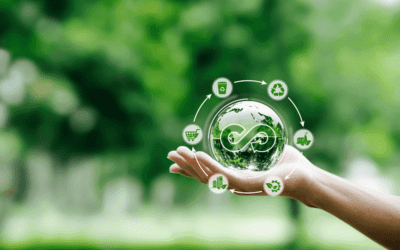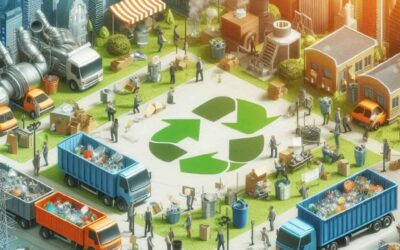Exploring why different countries are using technology to make recycling more efficient, in order to contribute to reducing the climate emergency.
Climate problems have become an increasing concern in recent years, leading many countries to explore ways to reduce their impact on the climate. One means of doing this is to address issues with waste, and adopt a more circular method, where the products and materials present in domestic and industrial waste are reused.
Climate emergency – the problems
There is a currently more and more recognition among experts that we are in a global climate crisis. A widely read article published in BioScience in 2019, signed by over 11,000 scientists from around the world stated “clearly and unequivocally that planet Earth is facing a climate emergency.”
Many experts agree that we are likely to see an increase in the amount of global warming that humans have cased to reach 1.5 °C above pre-industrial levels by 2030. After this point irreversible damage will occur to the planet. Climate change must be averted by maintaining the global temperature increase below 1.5°C. Currently we are not on track to achieve this. Global governmental policy currently lags behind private sector innovation in this field.
In addition to rising temperatures we are now using more of Earth’s resources that it can regenerate. It is estimated we are using approx x1.75 Earth’s capacity. According to Earth Overshoot Day, in 2021 we reached Earth Overshoot day for that year on 29 July marking when in that year we have exceeded what the Earth can regenerate in that same year.
Waste management companies are now looking towards their own business practices to see what changes they can make to avert contributing to the climate emergency, and become more sustainable in their working methods.
Waste management – the problems
There is a global Waste Crisis. Waste is widely recognised as part of the Climate Crisis. It is estimated that the world is producing approx 2bn tonnes of solid waste each year. The current rate of consumption is not sustainable. Recycling is recognised as one of several solutions to the problem. This will also help reduce the need to extract minerals and raw materials from the earth by recirculating existing materials in their place.
Circular economy – a solution
A circular economy can be defined in the following way:
“The circular economy is a model of production and consumption, which involves sharing, leasing, reusing, repairing, refurbishing and recycling existing materials and products as long as possible. In this way, the life cycle of products is extended.”
Solutions which we can help implement with Waste & Recycling One
As describe above, the circular economy is a method of reducing raw materials extraction and circulating materials by recycling. GDP Growth without recycling and circular economy infrastructure equates to more waste and required recycling capacity.
Everyone must reduce, reuse and recycle. Brands have social and commercial pressure to reduce cost and become more environmentally friendly. Global Brands have more to lose and everything to gain by becoming more circular. Social & Commercial Pressure on Brands to Recycle. Public & Private Sector to Divert Waste to Recycling. Private Sector Innovation to Create Circularity
Government has to create policy to avert climate change, reduce waste and create circular economy. Government, local authorities and municipalities are obligated to divert waste and increase recycling. Governments Must Finance Waste & Recycling to Attain Targets. Governments must fund private and public waste and recycling infrastructure. GDP Growth Requires Waste & Recycling Infrastructure. Policy & Law on use of Recycled Materials.
How Waste & Recycling One helps waste and recycling companies adopt a circular economy process
Circular Economy
Manage the transactions, information and intelligence between different actors in circular economy supply loops. There are a vast range of functions within the software to manage material and product flows, logistics, transport, production, inventory and sales processes. Traceability and auditability of activities with their associated operational and accounting transactions. Including the comprehensive communications and customer service processes handled as standard throughout the integrated functionality of the software platforms.
Linear Models for Transparent Transition
Improve waste materials transport, plant and depot management. Production routines, inventory and integrated accounting cycles. Transitioning from linear models of consumption and product manufacturing to collaborative, circular supply. Easily embedding loops and regenerative material flows, value added activities, transactions and communications between customers, suppliers and partners, automatically.
Resource Inputs for Materials Management
Manage the intricate resource inputs and reprocessed material outputs within a supply loop. Determining product and materials components and characteristics, management of production, material yields from recyclable products and parts. Assignment of goods into a production process, managed inventory for sale of goods for secondary use. Delivering greater control and lowering environmental impact.
Waste Materials for Precise Production
Manage logistics for organic and technical nutrients. Control as resource inputs, administer into a production process and provide an output into a supply loop. Feedstock input, quality, sampling control, characteristics and components for specialised reprocessing and refurbishing. Native cloud functionality and integrated to accounting processes for operational connection, collaboration and financial control.
Material Loops & Lifecycles Promoting Partnerships
Handle the complex process of materials management in supply loops. Traceability and auditability of resource materials, parts, products and lifecycles. Operational and accounting transactions and processes to track and control assets, products, materials and value added activities. Delivering information and intelligence between partners. Facilitating easy, transparent transactions between entities in the supply loop.
Circular Design as Evolutionary Support
Waste & Recycling One is a bimodal platform to perform waste logistics and recycling materials operations. Utilising SAP’s inherent skills in integrated business management software to provide extensive functionality in materials management, manufacturing, production and inventory, coupled with a low code platform to deliver an affordable, flexible suite of tools for innovating and diverse, dynamic, growing circular business models.
Repair & Maintenance to Champion Durability
Manage intricate business models focused on the longevity of technical products and materials in circulation. Extensive product and materials tracking, asset maintenance, lifecycle, production, service, refurbishing, warranty and inventory functionality ensures that product endurance and material recovery can be maintained and extended with innovative, efficient, cost-effective processes and functions.
Remanufacture Products to Reconstruct & Renew
Manage rebuilding of products using inventory from a variety of suppliers. Extensive customer and supplier management, production, routing, parts, warranty, service controls with preintegrated financial and accounting cycles. Ensuring the ability to redesign, remanufacture and rebuild within a supply loop. Dynamic, innovative manufacturing and maintenance, delivering inventory and effort cost controls.
Refurbishing Products to improve Performing Processes
Manage the intricate manufacturing processes for refurbishing products. Comprehensive customer, supplier, product information, inventory, production order and work centre monitoring procedures. Configured to meet the requirements of multiple complex refurbishing production lines. Ensuring planning for profitable reconditioning oversight and production lines perform against target resource, effort and inventory control.
Circular Business Models to lay Future Foundations
Help support innovative circular business models. Helping organisations in recycling loops, platform models, business process efficiency, analysis of product life cycles, support services, warranty and upgrades by tracking circulation and phases. Providing a platform to support innovations, operations and accounting functions that facilitate an easy transition to a circular economy.
Cradle to Cradle LIfecycle Guardianship
Waste & Recycling One Helps support business ecosystems manufacture and circulate technical and biological nutrients in optimum lifecycles. Composition, components, serial, batch, lifecycle and warranty functions underpin repair and recycling, disposal and neutralising material processes within supply loops. Accounting, logistics and IoT innovations ensure further efficiency and compliance.
Resource Recovery to Circulate Value
Manage the reuse, recycling and reprocessing of waste materials to create valuable outputs for secondary markets. Facilitating transport and logistics, tracking materials, characteristics and composition, manufacturing, inventory and accounting processes, ensuring sustainable inbound feedstocks, optimum manageable capacities and profitable yields.
Product Lifecycle to ensure Profitable Performance
Manage product life cycles. Comprehensive master data, serial and batch auditability, materials, composition, character and yields. Supporting recycling, remanufacture and refurbishing production line operations. Accounting, value, maintenance, service, warranty, and reverse logistics routines ensure of total process management in materials and product circulation performance.
See how our Waste and Recycling One solution can help.






